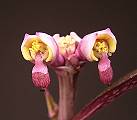

|
|
| About Euphorbiaceae
Cultivation - Soil and Feeding
|
The soil performs three basic functions for plants:
- The soil should give the plants a chance to root down and hold firm. In cultivation, this means the soil must not be too dense and prevent the roots penetrating. Furthermore, the soil must be well-drained so that surplus water can run away and so avoid root rot.
- The soil needs hold a certain amount of moisture for use by the plants.
- Finally the soil should provide the plants with necessary nutrients for the growing season. Plants in pots rapidly exhaust the soil and need regular feeding or repotting when required.
After repotting, plants get all the nutrients they need from the new soil, but they soon use them up and need feeding. There are two main groups of fertilizer which differ in content. The so-called complete fertilizers contain nitrogen (N), phosphates (P) and potash (K). It is preferable to choose fertilizers with a low nitrogen content, but as the composition of all fertilizers varies considerably, it is best to vary the brand from time to time to avoid a deficiency of any particular component. Complete fertilizers also contain trace elements besides the normal components. These are required by plants, but with sufficient use of complete fertilizers and regular repotting, it is rarely necessary to use special fertilizers with these trace elements. However if you feel the need to use trace elements, please carefully follow the instructions, as an overdose can kill the plants. During the growing season regular but light fertilizing is recommended. Repotting small or slow-growing species is not necessary every year. Faster-growing species, however, can exhaust the soil after a year, despite regular feeding, although increasing the dose can delay the necessity to repot. However the danger of this system is that the plants can become torpid and susceptible to disease.
Monadenium rubellum |
